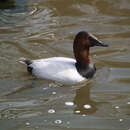Pair bonding - Canvasback pair bonding takes place in late winter. Most
canvasbacks arrive on their breeding grounds already paired [
12].
Nesting - Canvasbacks begin to nest in late April or early May [
1].
Even in the subarctic, canvasbacks nest almost as early as in the
northern prairies [
1]. The nesting season generally lasts from April to
June [
1,
12].
Clutch size/incubation - Determining the clutch size in canvasback nests
is complicated by the effect of redhead (Aythya americana) parasitism on
the number of host eggs. When redheads lay in canvasback nests, host
clutches are reduced in size. Clutches usually consist of 7 to 12 eggs
and average 9 1/2 in nonparasitized nests. Clutches are somewhat
smaller in parasitized nests [
1,
8]. Female canvasbacks seldom lay eggs
in the nests of other species but commonly parasitize the nests of other
canvasback hens [
1].
The incubation period normally lasts about 24 days but sometimes as long
as 29 days [
7,
8]. The inclusion of eggs laid by other females sometimes
results in several unhatched eggs being left in the nest at the time of
general hatching [
8].
Fledging - Fledging requires about 56 to 68 days [
8].
Age at sexual maturity - Canvasbacks become sexually mature their first
winter [
7,
8].
Molting - Drakes begin to gather on molting grounds shortly after
females start incubation. Most have completed their prenuptual molt by
mid-October or early November. Hens begin to molt after leaving their
broods in the fall [
7].
Migration/Fall - Canvasbacks begin to migrate into the Northern Great
Plains in early September. Numbers slowly build up to late October,
followed by rapid departures in early November. Canvasbacks in the east
arrive in the Great Lakes States in early October, reach peak numbers by
early November, and decline rapidly to wintering numbers by the end of
the month. Canvasbacks arrive on their winter grounds adjacent to the
central Gulf Coast in late November. Farther south on the lower Texas
coast, however, they arrive almost a month earlier [
1]. They arrive on
winter grounds in central California in late October, and numbers
steadily increase through November and December. On winter grounds in
southern California, canvasbacks do not appear until late November and
rapidly increase in numbers through December [
1].
Migration/spring - Canvasbacks begin departing many of their winter
areas in early February. On most winter areas, there is a steady
departure lasting almost to mid-April. On lakes midway to their
breeding grounds, canvasbacks appear in small numbers in late February,
with populations rapidly increasing through March. Canvasbacks begin to
arrive on the southern margins of their breeding grounds in the Great
Plains in early April [
1].

